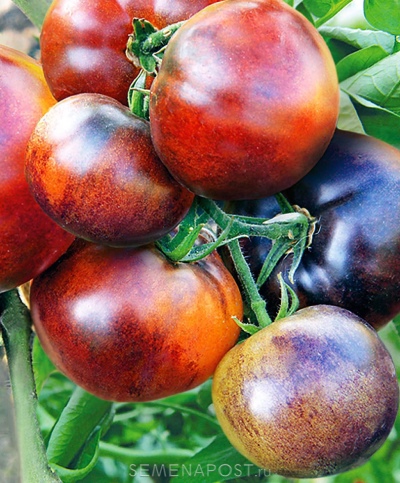
- Authors: Myazina L.A.
- Year of approval: 2015
- Category: hybrid
- Growth type: determinant
- Appointment: universal
- Ripening period: early
- Ripening time, days: 100
- Growing conditions: for open ground, for film greenhouses
- Bush height, cm: 75-100
- Foliage: weak
Tomato Ivan da Marya is already by its name cozy and pleasant. But in order for such expectations to be embodied on the site, it is necessary to thoroughly familiarize yourself with its features. Among other things, it is advisable to pay attention to the treatment of such a culture.
Breeding history
Tomatoes Ivan da Marya were created under the guidance of breeder Myazina L.A. The official registration of such a variety was made in 2015. Therefore, it can be considered one of the best achievements of domestic developers over the past decade.
Description of the variety
Ivan da Marya is a determinant hybrid. Therefore, its seeds are unsuitable for subsequent planting while maintaining the main characteristics. The growth of the bushes ranges from 0.75 to 1 m. The number of leaves will be relatively small. They are short and dark green in color.
The main qualities of the fruit
The unripeness of the unripe berries of Ivan da Marya is expressed in the fact that they develop not a green, but a purple spot. The rest of the tomato surface is dominated by a light green color. Fully ripe specimens acquire a reddish-brown tint. The usual fruit weight is 150 g; they are round and have only weakly developed ribs. The berries will form on simple inflorescences, covered with a smooth glossy skin.
Taste characteristics
The flesh of Ivan da Marya is fleshy, which significantly increases the gastronomic assessment. They also note the density of the main part of the tomato. It will taste sweet. The peel does not play a significant role in the overall balance of flavors.
Ripening and fruiting
Ivan da Marya will ripen very early. On average, 100 days pass from discarding green shoots to the beginning of harvesting. But in specific years in a specific situation, this period, of course, may differ. Berry picking is possible in July, August and September.
Yield
The possibility of collecting up to 15 kg of fruits per 1 m2 is declared. Only diligent and responsible farmers can achieve this effect. In the open field, the result will always be worse than in plastic greenhouses.
The timing of planting seedlings and planting in the ground
It is necessary to sow seeds in containers in the first decade of March. If this condition is met, transplanting into the ground is possible already at the beginning of May. Of course, they are also guided by the state of the seedlings.

Growing tomato seedlings is an extremely important process, because it largely depends on whether the gardener can harvest at all. All aspects must be taken into account, from seedbed preparation to planting in the ground.
Landing scheme
There should be no more than 3 plants per 1 "square" of gardening grounds. Anything that is denser is already too tight for a tomato. It is strongly recommended to plant it according to the rule of 700x400 mm.

Growing and care
The formation of bushes can be done in 1 or 2 stems.Frost exposure must be avoided because it damages the plants very much. Regular shelter is required until strong warm weather sets in. It is advisable to create holes 20 cm deep. A small amount of humus and superphosphate must be laid out in them.
You can limit growth by pinching the top. "Fitosporin" and other contact-action insecticides help to fight fungi. Among insects, the bear is the most dangerous. Sowing seeds directly into open ground is carried out only in the southern regions of Russia. And even there, seedling cultivation is optimal.




A plant needs different micronutrients at each stage of growth. All fertilizers can be divided into two groups: mineral and organic. Folk remedies are often used: iodine, yeast, bird droppings, eggshells.
It is important to observe the rate and period of feeding. This also applies to folk remedies and organic fertilizers.


Growing regions
Ivana da Marya can be grown in various regions of Russia, belonging to almost any part of it. The only exceptions are, perhaps, the areas of the Far North. Success can await farmers:
Kurgan region and other territories of the Urals;
Moscow region;
Saratov, Astrakhan regions and other Volga regions;
Kursk, Tambov and other black earth territories;
north, center and north-west of the European part of Russia;
Siberian and Far Eastern territories, regions;
territories and republics of the North Caucasus.
Review overview
Even experienced gardeners are inspired by the result of growing Ivan da Marya. In addition to purely gastronomic qualities, this variety also surprises with its decorative effect. It is extremely rare that those who have tried to grow such a culture at least once refuse it. The grooming needs are no higher than those of most common varieties. Therefore, at least to experience such a plant on your site will not be superfluous.

























































































